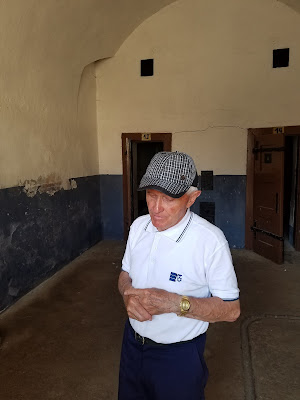When people around the world talk of Nazi atrocities during World War II, the name Terezin rarely comes up...it wasn't used to exterminate the Jews but rather as a transit camp. About 140,000 people passed through Terezin's gates; more than half ended up at the death camps of Auschwitz and Treblinka.
In 1941 the Nazis removed the town's 7,000 inhabitants and brought in 60,000 Jews, creating a concentration camp. This was the Nazis' model "Jewish town", a concentration camp beautified and staged for propaganda purposes. A film was made to show this mythic, idyllic city.
The Red Cross was allowed to visit Terezin once. The ghetto of Terezin was spruced up for the occasion--flower beds were added, pavilions were built. Sick prisoners were sent to their deaths at Auschwitz. Certain inmates were dressed up and told to stand at strategic places along the specially designated route through Terezin. Shop windows along that carefully guarded path were filled with goods for the day. Children were told to smile and look happy. It all worked...the Red Cross reported that while war time conditions made all life difficult, life at the Terezin ghetto was acceptable given all the pressures and that the Jews were being treated all right. They did not realize it was a concentration camp. Several months later many, including those smiling children, were deported East and murdered.
The words above the gate at Terezin is a German phrase meaning "work sets you free".
Washrooms were built specifically to fool the Red Cross. They were never used; the water pipes were never connected.
It was all a carefully planned deception intended to convince Red Cross inspectors that the Jews were being treated well.
The prisoners were held in big barrack buildings. Men, women and children lived separately
in large common rooms where there was only the most basic equipment--three-tiered bunks, a table and shelves. The common rooms were immensely overcrowded. In each of the barracks there were crowded together 100 to 400 people.
This is Cell #1 that Gavrilo Princip, the 20-year old assassin of Archduke Franz Ferdinand and his wife in 1914, occupied. The assassination in Sarajevo was the start of World War I.
Terezin was not an extermination camp. It was mainly designed as a slave labor camp and a transit camp as prisoners were sent here for a short time before being transported to the death camps.
The Nazis did not want the nearby townspeople to observe the transports and become suspicious so the Jewish prisoners were forced to construct a railway line that led right to Terezin...and back out again to Auschwitz.
We learned how horrific the conditions were from our local guide, Charles. Starvation and disease proved rampant. Thousands died of malnutrition and exposure.
Although Terezin was not an extermination camp, many died here. The bodies were cremated and then to erase the evidence, the ashes of many Terezin victims were dumped into the river at the end of the war.
 |
| The crematorium |
 |
| Inside the crematorium |
The dominant feature in the Jewish cemetery where 9,000 are buried is a stone menorah.
There is also a museum on the grounds of Terezin with exhibitions that portray the everyday turmoil and suffering that prisoners experienced.
We all came away saying, "We must never forget--it must not happen again".
It poured rain as we left the museum, which cut the remainder of our visit to Terezin short.
We headed back to the hotel with plenty of time to relax and pack up our luggage as we would be traveling to Vienna in the morning.
We joined our friends to finish up the wines they did not want to pack home as several were ending their vacation here.
We then joined our Program Director, Irina for a farewell drink of champagne with our fellow Prague travelers.
From there we went to the Folklore Gardens restaurant where we caught the last few minutes of a dance performance and had a nice typical Czech dinner.
The next day we say goodbye to some of our group who were heading home. The rest of us head to Vienna. To continue reading about our adventure, scroll back up towards the top of this page and click in the right-hand column the link entitled: "Vienna, Austria"

























No comments:
Post a Comment